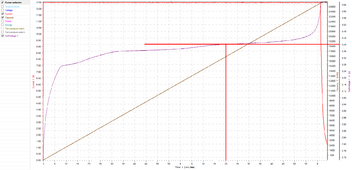I think the discussion here should be best taken to the optimal charging protocol for a single cell, not a series combination with a bms. If the 3.45 (or whatever) bulk limit, the 3.45 (or whatever) absorb, and 3.35 (or whatever) float is chosen because of balancing issues, so be it, but if it is because of electrochemical considerations of the electrodes, then that is more fundamental, and should be considered first.
I don't have a good answer, as I'm not knowledgeable with lifepos in particular, but I do understand electrodes, their thermodynamics, and kinetics pretty well, but more from a corrosion stance. I can imagine that modelling lifepo cathodes could be pretty complicated, as it involves solid state diffusion in the cathode. What I can say is that considering non-equilibrium kinetics (charging/discharging) is where a good deal of the complications arise. The most meaningful potential is that at open circuit, when there are no loads or charging, and after everything has relaxed, which can take some time. When you charge, there is an overpotential associated with ohmic loss in the electrolyte, an activation overpotential associated with driving the fundamental reaction a certain direction at a certain rate, and a diffusion overpotential, that results from the fact that some ions in solution have different diffusivities than others, and are essentially separated from one another (like a little capacitor) when they are pulled one way in an electric field, but at the same time are trying to even out concentrations due to diffusion. These overpotentials disappear when you stop charging and have no loads, after some time anyways. They are a strong function of current density, in varying and often complicated ways. What's determining the energy density of the system (roughly the soc) at this point is the electrochemical potential of the fundamental reactions, which is pretty straightforward, and the amount of 'stuff' at one electrode or the other.
All of the overpotentials result in efficiency losses, so you can see that the most efficient way to draw power from a battery, or charge it, is to draw infinitesimal currents, which is clearly not practical. It makes sense that you would try to hold a cell at its open circuit potential at full charge, which I understand is around 3.35V. It's entirely possible that some time is desirable at higher potentials for some reason related to the state of the electrodes - I just don't know.
I think what hwy17 is trying to get at is is there a point of ever being above 3.35 during a charge. The way I see it is yes, because for any meaningful charging current, there is an associated overpotential, so to snap back at the right open circuit potential of full-ish soc, you charge above it, but still below 3.65, and wait for current to taper down a bit. Outside of unknown (to me) electrode effects, you'd still get to the same soc by holding at 3.35 for infinite time, sort of like walking halfway to a wall each time you walk to it. The overpotentials diminish with decreasing current. So, in short, it is a 'time' reason. For a 16s battery, I can see there being reasons involved with the balancing dance, but these are separate.



